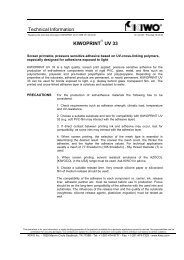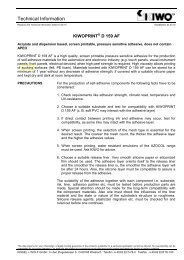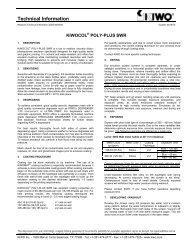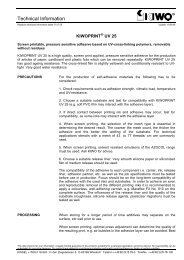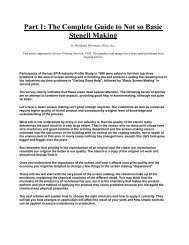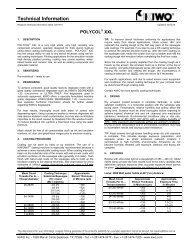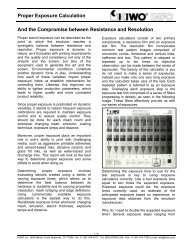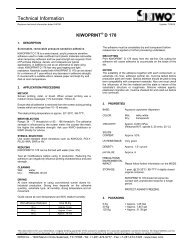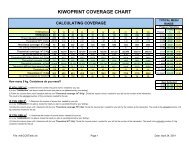Choosing the Right Emulsion for Your Application - KIWO
Choosing the Right Emulsion for Your Application - KIWO
Choosing the Right Emulsion for Your Application - KIWO
Create successful ePaper yourself
Turn your PDF publications into a flip-book with our unique Google optimized e-Paper software.
Length of print runThe longer <strong>the</strong> print run is, <strong>the</strong> more resistant <strong>the</strong> stencil has to be in both aspects,mechanical and chemical resistance. Some stencil systems can be rated <strong>for</strong> a certainlength of print run.Ink typeThere is a distinct trend towards two ink systems: water-based inks and UV-inks. Eachrequires a certain chemical resistance of <strong>the</strong> stencil. O<strong>the</strong>r applications such as ceramicprinting require high abrasion resistance, again o<strong>the</strong>r applications don’t required highchemical resistance at all, such as plastisol inks. Determine how "tough" <strong>the</strong> ink really isand choose an appropriate stencil. Probably <strong>the</strong> toughest ink systems are water-basedinks with solvents in <strong>the</strong>m.Quality requirements of <strong>the</strong> applicationEach application can be rated in <strong>the</strong> grade of quality requirements. A banner that flies on abuilding 30 feet above <strong>the</strong> ground does not necessarily require extremely sharp edges on<strong>the</strong> print, whereas a membrane switch has to have perfectly sharp edges. Printing a posteror four color process required a different type of stencil than a printed circuit board.Screen room equipmentMost important is <strong>the</strong> type of exposure system you have. A modern single point metalhalide lamp can usually handle all types of emulsions and quality requirements. Multipointlight sources such as fluorescent tubes require stencils with long exposure latitudeto handle <strong>the</strong> light undercutting of this type of exposure system. You may even have somespecial systems like a Computer-To-Screen system, a laser exposure unit, or a projectionexposure camera.Mesh countsThe range of mesh counts you may use may determine a certain viscosity in <strong>the</strong> emulsion.Coarse mesh counts require higher viscosity, high mesh counts ask <strong>for</strong> lower viscosity.Some emulsions are not suitable to be coated on fine meshes of coarse mesh counts,whereas o<strong>the</strong>rs may be suitable to handle everything from 63 tpi to 470 tpi.Solvent and water resistanceRequirements to <strong>the</strong> stencilMost stencil systems withstand all solvents used in screen printing. However some lowpriced solvents used as screen wash can contain water and can soften some stencilsystems. Very critical though is <strong>the</strong> high humidity in some many sou<strong>the</strong>rn states. Highhumidity in <strong>the</strong> print shop requires some water resistance of <strong>the</strong> stencil system used. If<strong>the</strong> stencil is affected by humidity, <strong>the</strong> emulsion becomes soft and tacky and will finallybreak down.
Mechanical resistanceDifferent stencil systems offer different durability. The choice depends very much on <strong>the</strong>length of <strong>the</strong> print run, <strong>the</strong> type of press and <strong>the</strong> shop layout. If <strong>the</strong> environment is verydusty and <strong>the</strong> screen has to be cleaned during <strong>the</strong> print run, mechanical resistance of <strong>the</strong>emulsion is a major factor and an emulsion with lower resolution will "cover up" dustparticles.Edge definitionEspecially <strong>for</strong> fine detail printing, <strong>the</strong> edge definition of <strong>the</strong> stencil system should be asgood as possible. Edge definition is not only <strong>the</strong> sharpness of <strong>the</strong> edge but <strong>the</strong>smoothness of <strong>the</strong> vertical plane in <strong>the</strong> emulsion build up. If <strong>the</strong> vertical plane of <strong>the</strong>emulsion is not smooth enough, <strong>the</strong> ink release is very difficult resulting in loss of detail.The rougher <strong>the</strong> edge , <strong>the</strong> easier <strong>for</strong> <strong>the</strong> ink to hold to it. A smooth edge aids <strong>the</strong> inkrelease and results in better detail reproduction.Rough Stencil Wall - Poor Edge DefinitionSmooth Stencil Wall - Good Edge DefinitionMesh bridgingMesh bridging is <strong>the</strong> ability of <strong>the</strong> emulsion to cross a mesh opening in a straight line, nomatter in what direction and how far away from <strong>the</strong> threads of knuckles <strong>the</strong> image edge islocated. Some emulsions will not show perfect edge bridging with thin emulsion build up.Bad mesh bridging results in distortion of <strong>the</strong> image and sawtooth effects.
ResolutionResolution has to be considered relative to mesh bridging and edge definition. Resolutionis defined as <strong>the</strong> ability of <strong>the</strong> emulsion to reproduce finest details on <strong>the</strong> screen. If youimagine that a fine dot of , <strong>for</strong> example, 50 micron diameter has to be reproduced, and <strong>the</strong>emulsion does not offer excellent mesh bridging and edge definition, <strong>the</strong> edge of <strong>the</strong> dotwill not be straight or smooth. This will automatically result in bad resolution, i.e. <strong>the</strong> dotmight be only 40 micron in diameter.Resolution can be defined as <strong>the</strong> finest line width resembling exactly <strong>the</strong> same width as<strong>the</strong> original. Fur<strong>the</strong>rmore, <strong>the</strong> resolution should be stated <strong>for</strong> <strong>the</strong> positive line, which is anopen line on <strong>the</strong> o<strong>the</strong>rwise covered screen. The resolution of <strong>the</strong> positive line will alwaysbe worse than <strong>the</strong> resolution of <strong>the</strong> negative lines (emulsion line on uncovered mesh).Mesh structure compensationMesh structure compensation is <strong>the</strong> ability of <strong>the</strong> stencil to fill and smooth out <strong>the</strong> woventhree dimensional structure of <strong>the</strong> mesh. In order to achieve an almost flat surface on <strong>the</strong>substrate side of <strong>the</strong> stencil.Only a very flat and smooth surface of <strong>the</strong> printing screen will have good contact to <strong>the</strong>substrate and create a perfect seal between screen and substrate. The contact betweenscreen and substrate will keep <strong>the</strong> ink from running under <strong>the</strong> edges of <strong>the</strong> printing imagemaintaining a sharp print.
Especially <strong>for</strong> fine detail printing perfect mesh structure equalization is essential, asunsharp prints or smearing enlarges <strong>the</strong> area covered by ink and results in severe imagedistortion or dot gain.The roughness of <strong>the</strong> screen depends on <strong>the</strong> coating technique and to a large extent onviscosity and solids content of <strong>the</strong> emulsion. A medium viscosity and solids content isusually <strong>the</strong> best choice <strong>for</strong> most applications.<strong>Emulsion</strong> over mesh ratioThe emulsion build up over mesh should be a minimum of 4 – 5 micron and a maximum of25% of <strong>the</strong> mesh thickness.The minimum emulsion build up is needed to enable <strong>the</strong> ink to flow underneath <strong>the</strong>threads in <strong>the</strong> mesh opening. If <strong>the</strong> emulsion build up is too low <strong>the</strong> ink will not cover <strong>the</strong>entire image area. This is especially important if thixotropic ink systems are used.When maximizing <strong>the</strong> emulsion build up it is necessary to keep <strong>the</strong> total thickness of <strong>the</strong>mesh / stencil structure low enough to assure easy ink release and low ink deposit.In <strong>the</strong> ideal case, <strong>the</strong> smallest image on our screen should be 100% larger in diameter orwidth than <strong>the</strong> mesh / stencil structure is in height.Diazo emulsions<strong>Choosing</strong> <strong>the</strong> stencil systemDiazo-sensitized emulsions can offer very good overall quality with acceptable exposuretimes. In moderate climates <strong>the</strong>se emulsions are suitable <strong>for</strong> fine detail printing. They areavailable as ei<strong>the</strong>r solvent or water resistant emulsions but un<strong>for</strong>tunately cannot offerperfect solvent resistance with good water resistance in one. Diazo stencils offeracceptable copying qualities.SBQ-Photopolymer emulsionsSBQ-Photopolymer emulsions are one component pre-sensitized systems with extremelyfast exposure times. Due to <strong>the</strong> exposure speed, <strong>the</strong> exposure latitude is very short and
<strong>the</strong> risk of ei<strong>the</strong>r over or under exposure is fairly high. Mesh bridging, resolution and edgedefinition can vary but is in most cases fully comparable with high quality diazoemulsions. This system offers very good resistance to humidity and is available in waterand solvent resistant versions. The resistances, however, can not match <strong>the</strong> resistancesof Diazo-photopolymer systems.Diazo-photopolymer emulsionsThe last and most suitable alternative are Diazo-Photopolymer emulsions. Diazo-Photopolymer emulsions are combinations of pre-sensitized ingredients in <strong>the</strong> emulsionplus a diazo sensitizer. This system offers superior quality in all respects. Mesh bridging,edge definition, resolution, resistance, mesh structure equalization and exposure latitudesare excellent <strong>for</strong> all applications. These emulsions are not affected by humidity. The wideexposure latitude of almost 200%, in some cases, offers very high production security andeliminates possible down times due to false exposure. Even if <strong>the</strong> screen has been highlyoverexposed only minimum changes in image sizes are noticeable.SummaryBe<strong>for</strong>e you go out and buy any type of stencil system, you should walk through your shopand examine <strong>the</strong> environment. Determine <strong>the</strong> quality you can achieve with your screenroom equipment and possibly select a stencil system that counters some of <strong>the</strong>shortcomings in <strong>the</strong> equipment. <strong>Your</strong> inks and presses give you fur<strong>the</strong>r clues to what toask <strong>for</strong> and finally determine <strong>the</strong> amount of screens you have to make each day.With this in<strong>for</strong>mation you are able to easily eliminate many of <strong>the</strong> offered stencil systemsand finally pick one or two that may be best suitable <strong>for</strong> your specific needs. <strong>Choosing</strong> <strong>the</strong>right stencil system <strong>for</strong> your application can be fairly easy, once you know yourrequirements and your budget. Without knowing your requirements, you may end up witha stencil system that gives you nothing but trouble and costs you a <strong>for</strong>tune.




